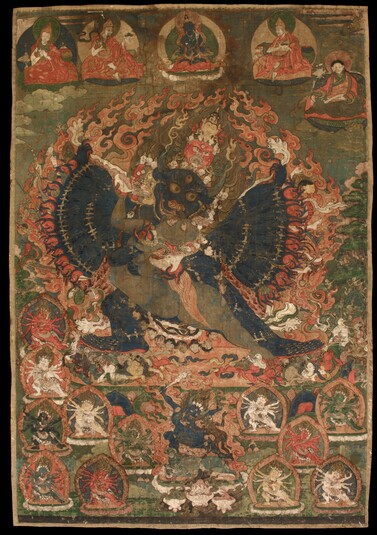
Item: Vajrabhairava (Buddhist Deity) - with consort
| Origin Location | Tibet |
|---|---|
| Date Range | 1700 - 1799 |
| Lineages | Gelug and Buddhist |
| Material | Ground Mineral Pigment on Cotton |
| Collection | Arthur M. Sackler Gallery, Smithsonian Institution, Washington, D.C. |
| Catalogue # | S1999.5 |
Classification: Deity
Appearance: Animal-Feature
Gender: Male
Vajrabhairava with Vajra Vetali (Tibetan: dor je jig je. English: Vajra Terror) a wrathful form of Manjushri.
As a tutelary deity Vajrabhairava, also known as Yamantaka, belongs to the Bhairava and Yamari class of tantras and specifically arises from the Vajra Bhairava Root Tantra (Tibetan: jig je tsa gyu). All of those belong to the method (father) classification of Anuttaryoga Tantra. The practice of Bhairava is common to the three Sarma Schools: Sakya, Kagyu and Gelugpa. Among the Sakya it is counted as one of the four main tantric deities. There are numerous forms and styles of practice from the very complex with numerous deities to the very concise with a single Heruka form. The main lineages to enter Tibet were those of Jowo Atisha, Rwa Lotsawa, Mal Lotsawa and the like.
This form of Bhairava with the central faces placed 3 vertically and 3 faces to each side arranged horizontally is unique to the Gelugpa School and true to a visionary experience of Lord Tsongkapa the founder.
Lineage: Shri Vajrabhairava, Jnana Dakini, Mahasiddha Lalitavajra, Amoghavajra, Yeshe Jungne Bepa, Mahasiddha Padmavajra, Marmedze Srungwa, Rwa Lotsawa Dorje Drag, Rwa Chorab, Rwa Yeshe Sengge, Rwa Bum Seng, Rongpa Gwalo Namgyal Dorje, Rongpa Sherab Sengge, Lamdrepa Yeshe Palwa, Je Sonam Lhundrup, Choje Dondrup Rinchen, Je Tsongkapa Lozang Dragpa (1357-1419), etc.
Jeff Watt 7-98
Buddhist Deity: Vajrabhairava Main Page
Collection of Arthur M. Sackler Gallery, Smithsonian Institution
Buddhist Deity: Vajrabhairava Thirteen Deity Configuration

